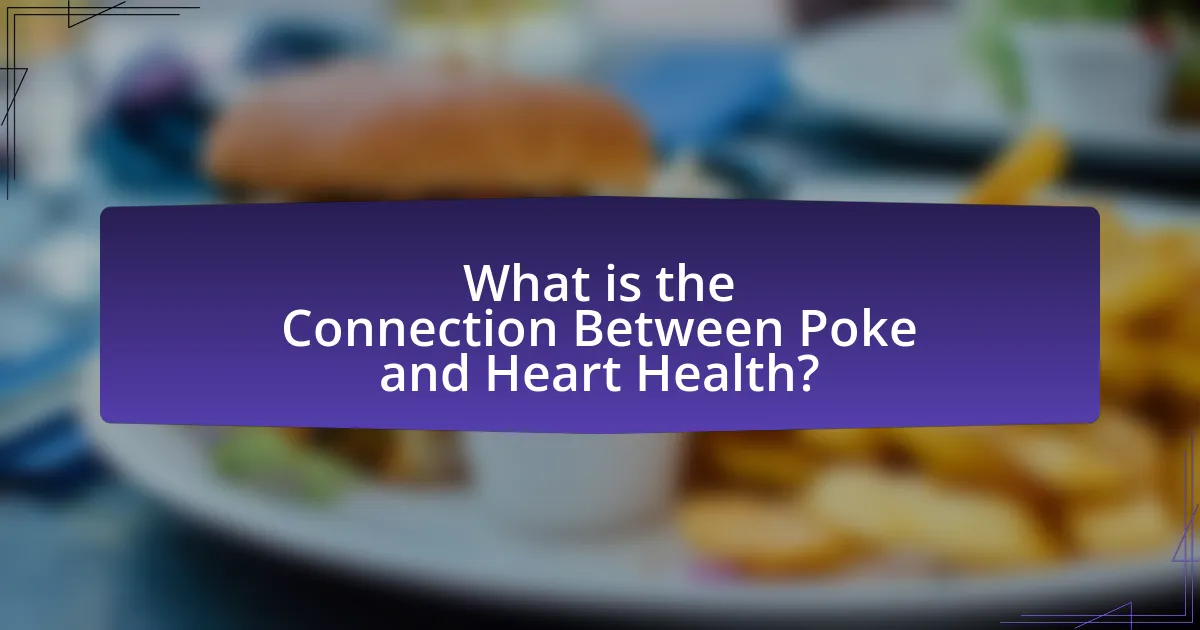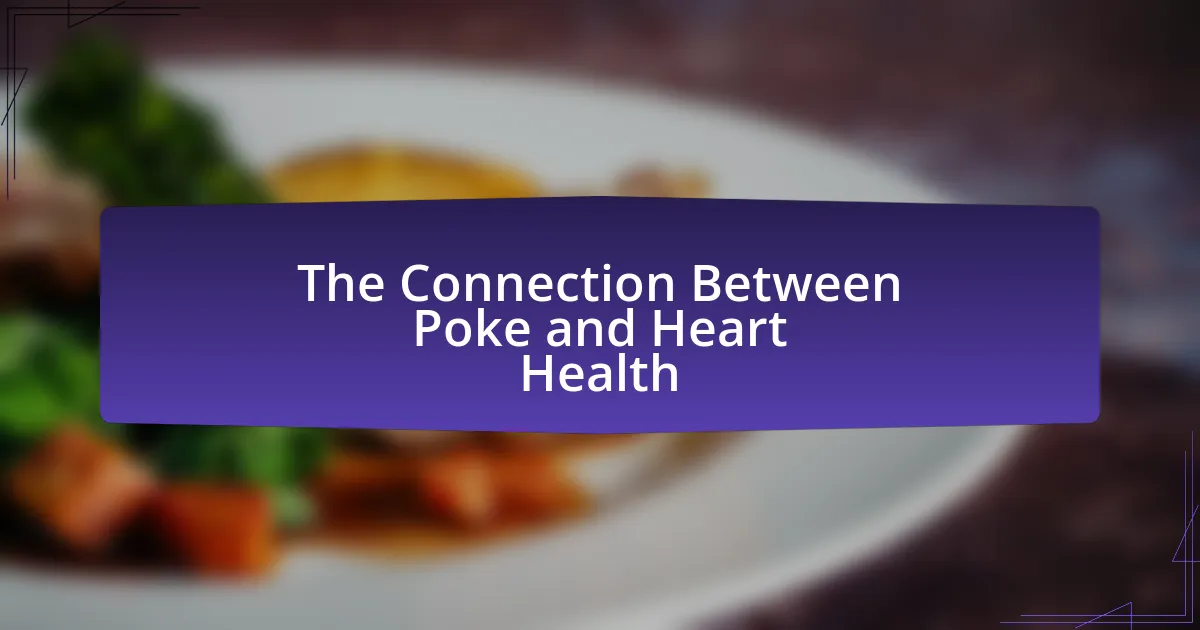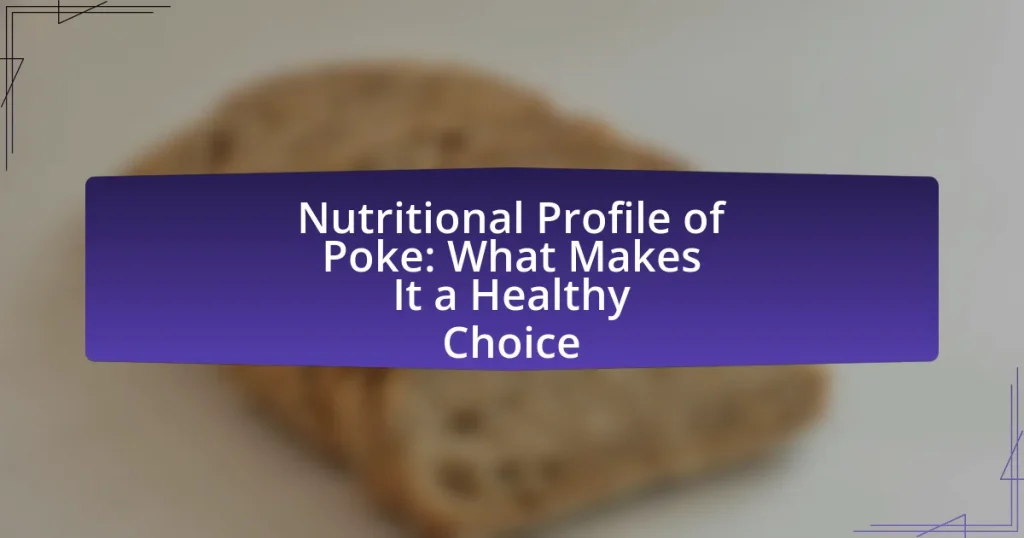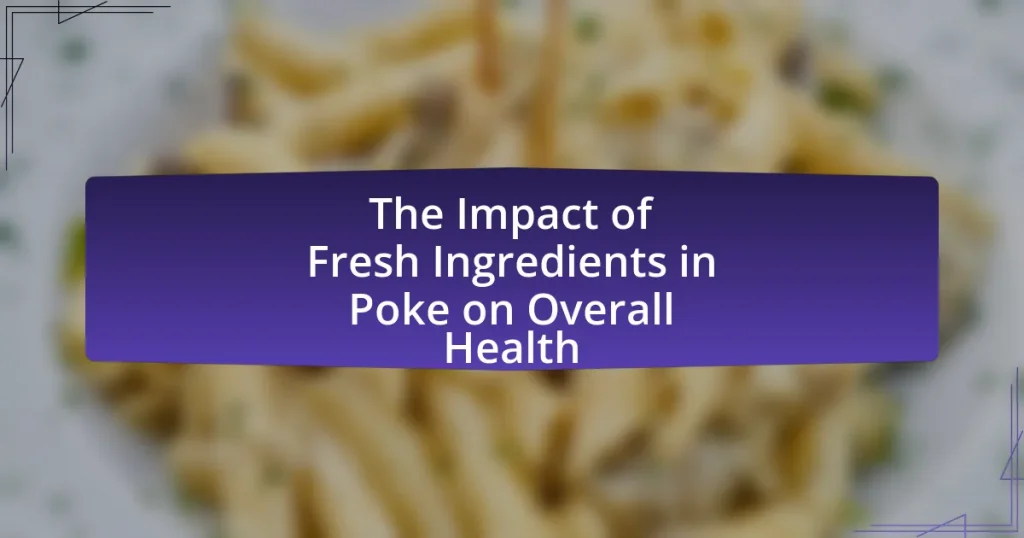Poke, a traditional Hawaiian dish made primarily with raw fish, is linked to improved heart health due to its high omega-3 fatty acid content. Omega-3s, found in fish like tuna and salmon, are known to reduce inflammation, lower blood pressure, and decrease triglyceride levels, thereby lowering the risk of heart disease. The article explores the nutritional components of poke, including the benefits of fatty fish and fresh vegetables, while also addressing potential risks associated with raw fish consumption and high sodium levels. Additionally, it provides guidelines for incorporating poke into a heart-healthy diet, emphasizing the importance of balanced ingredients and portion control.

What is the Connection Between Poke and Heart Health?
Poke, a traditional Hawaiian dish primarily made with raw fish, is beneficial for heart health due to its high omega-3 fatty acid content. Omega-3 fatty acids, found abundantly in fish like tuna and salmon, are known to reduce inflammation, lower blood pressure, and decrease triglyceride levels, all of which contribute to improved cardiovascular health. Studies indicate that regular consumption of omega-3-rich foods can lead to a lower risk of heart disease, as evidenced by research published in the Journal of the American College of Cardiology, which highlights the protective effects of omega-3s on heart health.
How does poke contribute to heart health?
Poke contributes to heart health primarily through its high omega-3 fatty acid content, which is known to reduce inflammation and lower blood pressure. Omega-3 fatty acids, found abundantly in fish used in poke, such as salmon and tuna, have been shown to decrease triglyceride levels and improve overall cardiovascular function. Studies indicate that regular consumption of omega-3s can lead to a 30-45% reduction in the risk of heart disease, highlighting the significant role poke can play in a heart-healthy diet.
What are the key ingredients in poke that promote heart health?
The key ingredients in poke that promote heart health include fatty fish, such as salmon and tuna, and fresh vegetables like avocado and seaweed. Fatty fish are rich in omega-3 fatty acids, which have been shown to reduce inflammation and lower the risk of heart disease. For instance, a study published in the Journal of the American College of Cardiology found that omega-3 fatty acids can significantly decrease triglyceride levels and improve overall heart health. Avocado provides healthy monounsaturated fats, which can help lower bad cholesterol levels, while seaweed is high in antioxidants and fiber, contributing to cardiovascular health.
How do omega-3 fatty acids in poke affect cardiovascular health?
Omega-3 fatty acids in poke positively affect cardiovascular health by reducing inflammation, lowering triglyceride levels, and improving overall heart function. Research indicates that omega-3 fatty acids can decrease the risk of heart disease by promoting healthy blood vessel function and reducing blood pressure. A study published in the Journal of the American College of Cardiology found that individuals consuming higher amounts of omega-3 fatty acids had a significantly lower risk of cardiovascular events, highlighting their protective role in heart health.
Why is heart health important?
Heart health is important because it directly impacts overall well-being and longevity. The heart is responsible for pumping blood throughout the body, delivering oxygen and nutrients to tissues while removing waste products. According to the World Health Organization, cardiovascular diseases are the leading cause of death globally, accounting for 32% of all deaths in 2019. Maintaining heart health reduces the risk of heart disease, stroke, and other serious health issues, thereby enhancing quality of life and increasing life expectancy.
What are the common heart health issues faced today?
Common heart health issues faced today include coronary artery disease, hypertension, heart failure, arrhythmias, and high cholesterol. Coronary artery disease, characterized by the narrowing of coronary arteries due to plaque buildup, is the leading cause of heart attacks. Hypertension, or high blood pressure, affects nearly half of adults in the U.S., increasing the risk of heart disease and stroke. Heart failure occurs when the heart cannot pump blood effectively, impacting millions globally. Arrhythmias, or irregular heartbeats, can lead to serious complications, while high cholesterol contributes to plaque formation in arteries. According to the American Heart Association, cardiovascular diseases remain the leading cause of death worldwide, highlighting the significance of addressing these common heart health issues.
How does diet influence heart health?
Diet significantly influences heart health by affecting cholesterol levels, blood pressure, and inflammation. Consuming a diet rich in fruits, vegetables, whole grains, and healthy fats, such as those found in fish, can lower the risk of heart disease. For instance, the Mediterranean diet, which emphasizes these food groups, has been associated with a 30% reduction in cardiovascular events according to a study published in the New England Journal of Medicine by Estruch et al. in 2013. Conversely, diets high in saturated fats, trans fats, and added sugars can lead to increased cholesterol levels and higher blood pressure, both of which are risk factors for heart disease. Therefore, dietary choices play a crucial role in maintaining cardiovascular health.

What nutritional components of poke support heart health?
Poke contains several nutritional components that support heart health, primarily omega-3 fatty acids, lean protein, and antioxidants. Omega-3 fatty acids, found in fish like tuna and salmon commonly used in poke, are known to reduce inflammation and lower the risk of heart disease by improving cholesterol levels. Lean protein contributes to muscle health and helps maintain a healthy weight, which is crucial for cardiovascular health. Additionally, the vegetables often included in poke, such as seaweed and avocado, provide antioxidants and fiber, which further support heart health by reducing oxidative stress and improving blood pressure.
What types of fish are commonly used in poke and their health benefits?
Commonly used fish in poke include tuna, salmon, and yellowtail, each offering significant health benefits. Tuna is rich in omega-3 fatty acids, which support heart health by reducing inflammation and lowering blood pressure. Salmon also provides high levels of omega-3s, along with vitamin D and selenium, contributing to cardiovascular health and improved immune function. Yellowtail, known for its lean protein content, is beneficial for muscle maintenance and overall health. These fish not only enhance the flavor of poke but also contribute to a heart-healthy diet.
How does the nutritional profile of salmon compare to tuna in poke?
Salmon has a higher fat content, particularly omega-3 fatty acids, compared to tuna in poke. Specifically, a 3-ounce serving of salmon contains approximately 22 grams of fat, with about 4 grams of omega-3s, while the same serving of tuna has around 1 gram of fat and significantly lower omega-3 levels. This difference in fat composition contributes to salmon’s benefits for heart health, as omega-3 fatty acids are known to reduce inflammation and lower the risk of heart disease. Additionally, salmon is richer in vitamin D and selenium, which are important for cardiovascular health, compared to tuna.
What role do vegetables and toppings play in the heart health benefits of poke?
Vegetables and toppings in poke contribute significantly to heart health benefits by providing essential nutrients, fiber, and antioxidants. These components help lower cholesterol levels, reduce inflammation, and improve overall cardiovascular function. For instance, ingredients like leafy greens, avocado, and seaweed are rich in vitamins, minerals, and healthy fats, which support heart health. Studies have shown that diets high in fruits and vegetables can reduce the risk of heart disease by up to 30%. Therefore, the inclusion of these elements in poke enhances its nutritional profile and promotes heart health.
How do portion sizes of poke impact heart health?
Portion sizes of poke directly impact heart health by influencing the intake of omega-3 fatty acids and sodium levels. Consuming appropriate portion sizes of poke, which typically includes fish rich in omega-3s like salmon or tuna, can promote cardiovascular health by reducing inflammation and lowering triglyceride levels. Conversely, larger portions may lead to excessive sodium intake, especially if the poke is prepared with salty sauces or toppings, which can increase blood pressure and negatively affect heart health. Studies indicate that a balanced intake of omega-3s is associated with a lower risk of heart disease, while high sodium consumption is linked to hypertension, underscoring the importance of portion control in maintaining heart health.
What is the recommended serving size for heart health benefits?
The recommended serving size for heart health benefits is typically 3 to 4 ounces of fish per meal, particularly fatty fish rich in omega-3 fatty acids. Research indicates that consuming this amount can significantly lower the risk of heart disease, as omega-3s are known to reduce inflammation and improve overall cardiovascular health. The American Heart Association supports this guideline, emphasizing the importance of including fish in a balanced diet for optimal heart health.
How can one balance poke with other dietary needs for optimal heart health?
To balance poke with other dietary needs for optimal heart health, one should focus on incorporating a variety of nutrient-dense ingredients while monitoring sodium and fat intake. Poke typically includes raw fish, which is high in omega-3 fatty acids beneficial for heart health, but it can also be high in sodium if soy sauce is used excessively. Therefore, using low-sodium soy sauce or alternative seasonings can help manage sodium levels. Additionally, adding vegetables like leafy greens, avocados, and nuts can provide fiber, vitamins, and healthy fats, further supporting cardiovascular health. Research indicates that a diet rich in fruits, vegetables, and healthy fats can lower the risk of heart disease, making it essential to balance poke with these components for optimal heart health.

What are the potential risks of consuming poke for heart health?
Consuming poke can pose potential risks for heart health primarily due to its sodium content and the type of fats present in some ingredients. Poke often contains soy sauce, which is high in sodium; excessive sodium intake is linked to hypertension and increased cardiovascular risk. Additionally, if poke includes fatty fish, while omega-3 fatty acids are beneficial, some fish may also contain higher levels of saturated fats, which can negatively impact heart health if consumed in large quantities. Studies indicate that high sodium intake can lead to elevated blood pressure, a significant risk factor for heart disease.
Are there any health concerns associated with raw fish in poke?
Yes, there are health concerns associated with raw fish in poke. Consuming raw fish can lead to foodborne illnesses due to pathogens such as Salmonella, Vibrio, and parasites like Anisakis. The Centers for Disease Control and Prevention (CDC) reports that raw or undercooked seafood can pose significant health risks, particularly for vulnerable populations such as pregnant women, young children, and individuals with weakened immune systems. Additionally, there is a risk of mercury exposure from certain fish species commonly used in poke, which can have detrimental effects on health, particularly for pregnant women and children.
What precautions should be taken when consuming poke to ensure safety?
To ensure safety when consuming poke, individuals should verify the freshness and quality of the fish used, as raw fish can harbor parasites and bacteria. It is crucial to source poke from reputable establishments that follow proper food safety guidelines, including maintaining appropriate refrigeration temperatures and using sushi-grade fish. According to the U.S. Food and Drug Administration (FDA), consuming raw fish carries risks, and proper handling can significantly reduce these risks. Additionally, individuals with compromised immune systems, pregnant women, and young children should avoid raw fish altogether to prevent foodborne illnesses.
How can individuals with specific health conditions enjoy poke safely?
Individuals with specific health conditions can enjoy poke safely by selecting low-sodium sauces, opting for cooked proteins instead of raw fish, and avoiding high-mercury seafood. For instance, those with hypertension should choose poke bowls that use fresh vegetables and whole grains while limiting added salts. Additionally, individuals with compromised immune systems should avoid raw fish to reduce the risk of foodborne illnesses. Research indicates that cooking fish can eliminate harmful pathogens, making it a safer option for vulnerable populations.
What are the best practices for incorporating poke into a heart-healthy diet?
To incorporate poke into a heart-healthy diet, prioritize fresh, high-quality ingredients and balance the nutritional components. Use lean protein sources such as tuna or salmon, which are rich in omega-3 fatty acids that support heart health. Include a variety of vegetables like avocado, seaweed, and cucumbers for added fiber and nutrients, while minimizing high-sodium sauces and toppings. Opt for whole grains like brown rice or quinoa instead of white rice to enhance fiber intake. Research indicates that diets rich in omega-3s can lower the risk of heart disease, making poke a beneficial option when prepared thoughtfully.
How can one create a balanced poke bowl for heart health?
To create a balanced poke bowl for heart health, include a variety of nutrient-dense ingredients that promote cardiovascular wellness. Start with a base of whole grains like brown rice or quinoa, which provide fiber that can lower cholesterol levels. Add a source of lean protein, such as salmon or tofu, rich in omega-3 fatty acids known to reduce inflammation and improve heart health. Incorporate a mix of colorful vegetables like spinach, carrots, and bell peppers, which are high in antioxidants and vitamins that support overall heart function. Top the bowl with healthy fats, such as avocado or a sprinkle of sesame seeds, which can help maintain healthy cholesterol levels. Finally, use a light dressing made from ingredients like olive oil and lemon juice to enhance flavor without adding excessive saturated fats. This combination of whole grains, lean proteins, vegetables, and healthy fats creates a heart-healthy poke bowl that aligns with dietary recommendations for cardiovascular health.
What alternatives can be used in poke for those with dietary restrictions?
For individuals with dietary restrictions, alternatives in poke include using tofu or tempeh instead of traditional fish, which caters to vegetarians and vegans. Additionally, quinoa or brown rice can replace white rice for those seeking gluten-free or whole grain options. For those avoiding soy, chickpeas or edamame can serve as protein sources. These alternatives maintain the poke’s nutritional value while accommodating various dietary needs.
What tips can help maximize the heart health benefits of poke?
To maximize the heart health benefits of poke, incorporate a variety of nutrient-dense ingredients such as leafy greens, avocados, and nuts. These additions provide essential vitamins, healthy fats, and fiber, which contribute to cardiovascular health. For instance, avocados are rich in monounsaturated fats that can lower bad cholesterol levels, while leafy greens are high in antioxidants that combat inflammation. Additionally, opting for low-sodium soy sauce or tamari can help reduce sodium intake, further supporting heart health.



